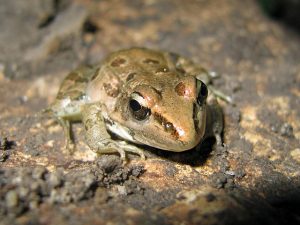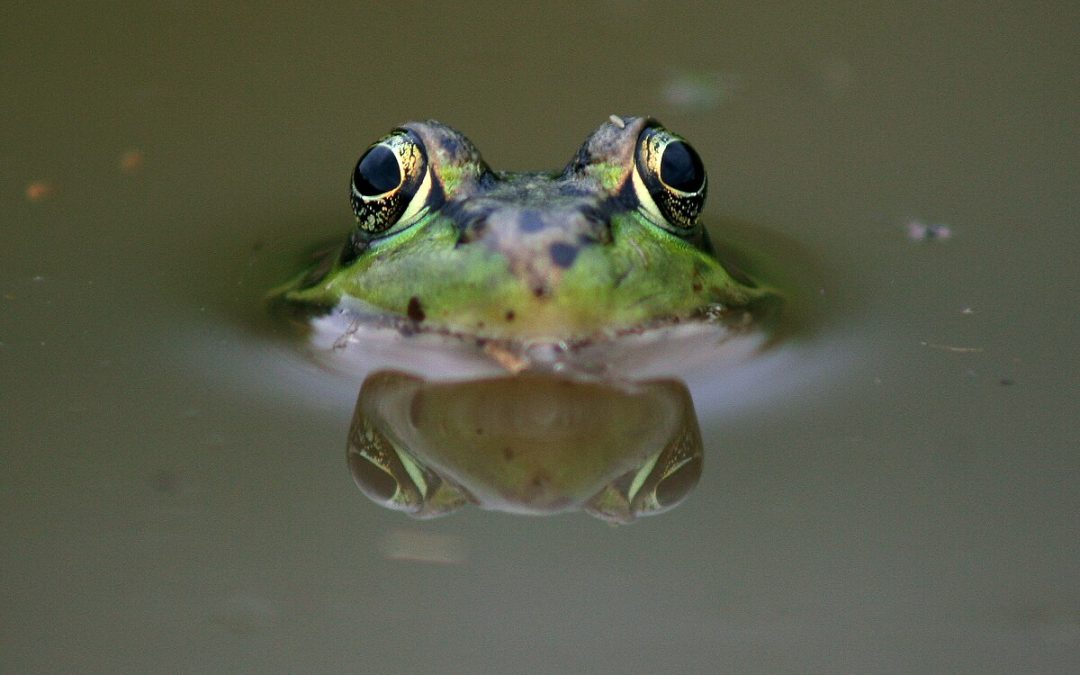Frog eyes © Pdunant
The bulging eyes of water and tree frogs differ more than they look.
 Prof. Mumblebard claims: “Semi-aquatic frogs have dorsally protuberant eyes placed above the level of the skull. This allows the animals to hide in water while spotting any predator approaching on land or from the air. Tree frogs – including those specialised to the degree of being able to glide from tree to tree – have similar placement of the eyes despite the fact that many of them hardly immerse themselves. The reason for this similarity is twofold. Firstly, not everything is adaptive: the ancestral design of the head has been conserved as frogs evolved from semi-aquatic to arboreal. Secondly, some of the advantages remain: although the water level is irrelevant to tree frogs, it pays them to keep their eyes high as in semi-aquatic frogs.” … See the hidden half of Prof. Mumblebard’s claim by subscribing here
Prof. Mumblebard claims: “Semi-aquatic frogs have dorsally protuberant eyes placed above the level of the skull. This allows the animals to hide in water while spotting any predator approaching on land or from the air. Tree frogs – including those specialised to the degree of being able to glide from tree to tree – have similar placement of the eyes despite the fact that many of them hardly immerse themselves. The reason for this similarity is twofold. Firstly, not everything is adaptive: the ancestral design of the head has been conserved as frogs evolved from semi-aquatic to arboreal. Secondly, some of the advantages remain: although the water level is irrelevant to tree frogs, it pays them to keep their eyes high as in semi-aquatic frogs.” … See the hidden half of Prof. Mumblebard’s claim by subscribing here
 Robin and the Honey Badger respond: “Semi-aquatic frogs can see only at and above the level of their eyes. This is because their eyes are close together, their pupils are tilted upwards and their wide jaws obstruct lines of sight. In tree frogs, by contrast, the visual field extends below the head because their eyes are far apart and bulge beyond the width of the jaws. Because their eyes face the sides and front more than those of semi-aquatic frogs, tree frogs can even see partway under the body and head. Any dorsal protrusion of the eyes in tree frogs is merely because the distance between the roof of the skull and the bottom jaw is less than in semi-aquatic frogs. Far from mounting the eyes as high as possible for maximum vigilance, tree frogs orient them to see downwards rather than upwards. In addition, the wide separation of the eyes in tree frogs gives them a relatively deep binocular field, allowing for the accurate assessment of distances when leaping to another perch. The crucial points, previously overlooked, are firstly that tree frogs see downwards whereas semi-aquatic frogs see upwards, and secondly that tree frogs have a more extensive field of binocular vision than that of semi-aquatic frogs. The visual differences between these groups of frogs show that each has adapted in its own way. This in turn means that phylogenetic constraint need not be invoked to explain any superficial resemblance in the positioning of the eyes between semi-aquatic frogs and tree frogs.”
Robin and the Honey Badger respond: “Semi-aquatic frogs can see only at and above the level of their eyes. This is because their eyes are close together, their pupils are tilted upwards and their wide jaws obstruct lines of sight. In tree frogs, by contrast, the visual field extends below the head because their eyes are far apart and bulge beyond the width of the jaws. Because their eyes face the sides and front more than those of semi-aquatic frogs, tree frogs can even see partway under the body and head. Any dorsal protrusion of the eyes in tree frogs is merely because the distance between the roof of the skull and the bottom jaw is less than in semi-aquatic frogs. Far from mounting the eyes as high as possible for maximum vigilance, tree frogs orient them to see downwards rather than upwards. In addition, the wide separation of the eyes in tree frogs gives them a relatively deep binocular field, allowing for the accurate assessment of distances when leaping to another perch. The crucial points, previously overlooked, are firstly that tree frogs see downwards whereas semi-aquatic frogs see upwards, and secondly that tree frogs have a more extensive field of binocular vision than that of semi-aquatic frogs. The visual differences between these groups of frogs show that each has adapted in its own way. This in turn means that phylogenetic constraint need not be invoked to explain any superficial resemblance in the positioning of the eyes between semi-aquatic frogs and tree frogs.”

Southern Leopard Frog (Rana sphenocephala) © Greg Schechter
Please join us here at the Bio-edge with your own comments. In the discussion below we encourage links to any evidence supporting either Prof. Mumblebard or Robin and the Honey Badger. Illustrations are welcome but please cite all sources or we may be forced under copyright to delete your comment.

